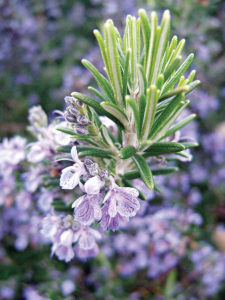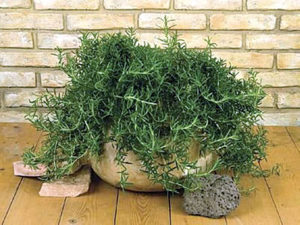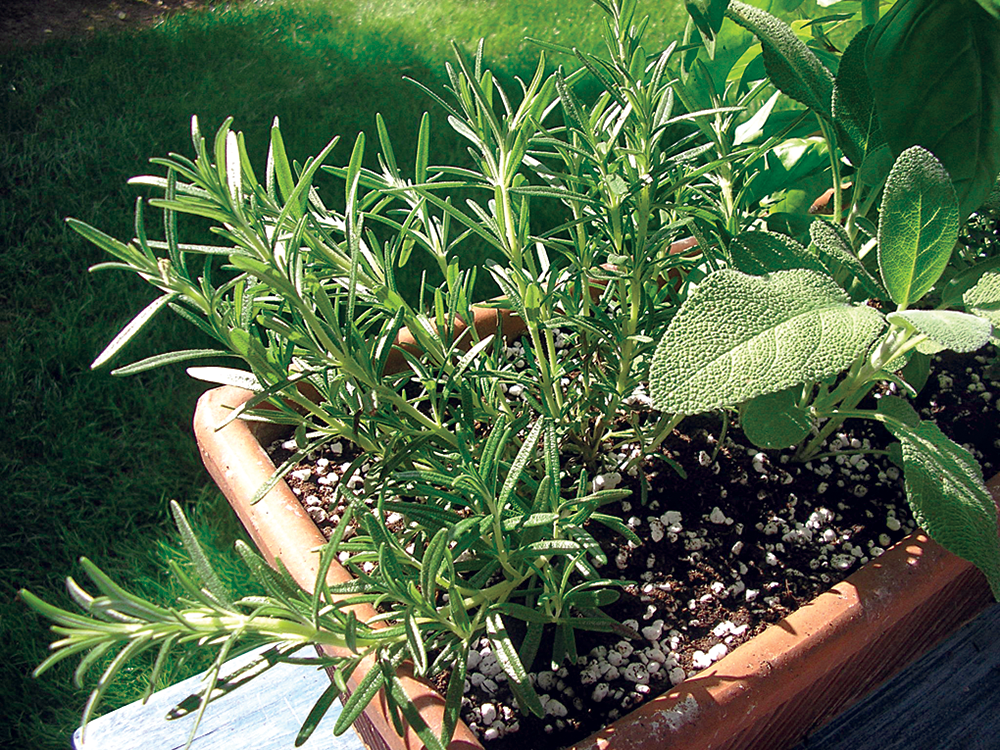Rosemary
Rosemary (Rosmarinus officinalis, ‘Dew of the Sea’) is a woody, Mediterranean perennial that grows where the summers are hot and sunny, the winters temperate and the soil fairly sandy and dry. These conditions are all clues to rosemary’s needs. She must have plenty of light, can’t stand temperatures below 0 degrees C, doesn’t like to be over-watered and needs good drainage.
 If you are thinking of keeping a rosemary through the season next year, it will be useful to know all of the above, but the most important item on the list is plenty of light. Most rosemary plants that die over winter do so from lack of light – they literally starve to death because they can’t photosynthesize in dim conditions. Keep your rosemary in a south-facing window where it will get lots of sunlight – it needs five to six hours a day – and cool air from the window glass.
If you are thinking of keeping a rosemary through the season next year, it will be useful to know all of the above, but the most important item on the list is plenty of light. Most rosemary plants that die over winter do so from lack of light – they literally starve to death because they can’t photosynthesize in dim conditions. Keep your rosemary in a south-facing window where it will get lots of sunlight – it needs five to six hours a day – and cool air from the window glass.
It really isn’t necessary to fertilize rosemary – remember its rough natural conditions – and it will give the best flavour from tough, relatively barren soils; however, if you are growing it in a container, summer fertilizing can give it a boost. Do take the indoor plant to the sink to water, soaking the soil, then letting all the water drain out of the pot before putting it back into its tray. It prefers slightly alkaline soils so sandy garden soil is better than the more acidic peat-based potting mixes.
Propagation
If you want to increase your rosemary plants, you can do so from cuttings. The seeds take a long time to grow to harvestable size and don’t always come true to the parents. Handle the cuttings as you would for any other plant: Take softwood cuttings of new growth. Strip off the bottom few leaves. Dip the stem in growth hormone and tuck the cutting into a nicely prepared potting soil mix. It should have roots in two to three weeks.

As the plant grows, you will want to increase its pot size. A terra cotta container will promote better air circulation around its roots than a plastic pot, but take care not to let it dry out completely. It’s pretty unforgiving if you do.
How to care for your rosemary
In the wild, many varieties of rosemary grow five to six feet tall. A potted rosemary, though, will need to be pruned to keep it to a manageable size. You can root prune when changing pots or refreshing soil periodically. Just be sure to prune an equal amount of the top of the plant at the same time. Don’t throw away the snippings. Hang them to air dry and store the leaves in an airtight container in a cool dry place. You can also freeze whole sprigs, pulling off needles as you ned them.
Rosemary is famous for its role in making lamb a very special dish, but rosemary is also wonderful added to marinades for beef or chicken or for potatoes. Remove and chop the leaves for use in dishes such as potatoes, carrots and pizzas or use the entire sprig as a garnish or to flavour a marinade.
Rosemary trivia
Rosemary is the herb of remembrance and has been studied for use in treating Alzheimer’s. It contains something called carnosic acid which is useful in fighting off free radical damage to the brain.
Rosemary is chock full of vitamin A. A few rosemary leaves can provide you with all the vitamin A you need in a day. The herb is also a great source of the B vitamins.
A few springs of rosemary on your doorstep should keep witches away. You can also put a sprig under your pillow if you are troubled by nightmares.






Pingback: Fresh rosemary chicken recipe - Your LOCAL Gardener